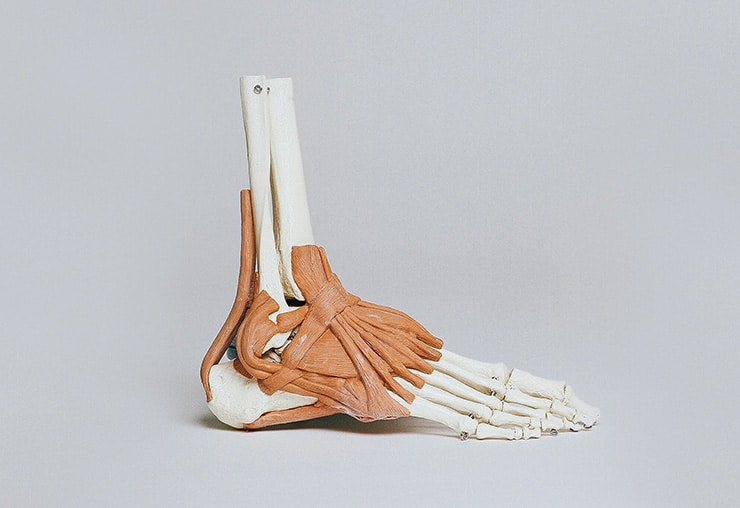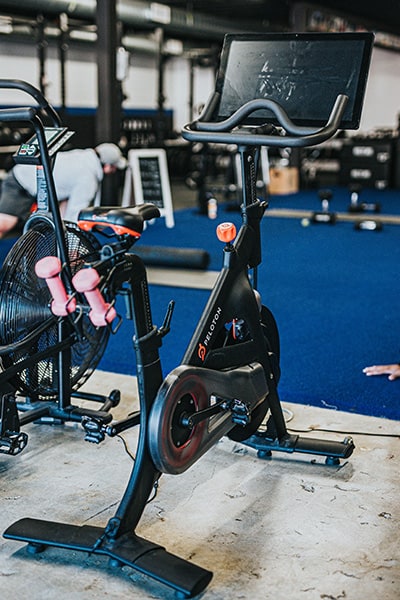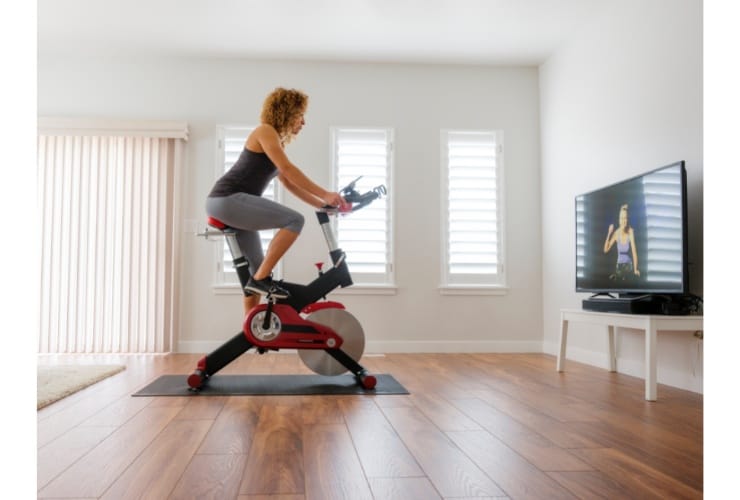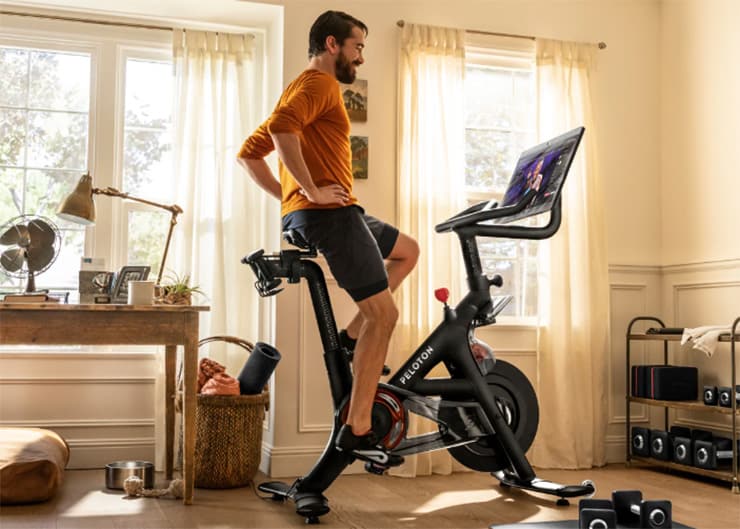Just because Pelotons are low-impact cycling machines doesn’t mean they can’t cause overuse injuries, muscle tension or other types of pain like plantar fasciitis.
Whether you’re a beginner or pro-Peloton rider, you may have experienced pain while cycling. Fortunately, you have come to the right place.
This ultimate guide to Peloton foot pain will explain the top causes of this phenomenon, provide the best solutions, and tell you everything else you need to know. Let’s get started.
Key Takeaways
- Riding a Peloton is a low impact exercise but it’s still possible to get muscle tension, overuse injuries, and other issues like plantar fasciitis.
- Some of the causes of foot pain while cycling are tight shoes, incorrect cleat position, incorrect foot position on the pedal, and improper saddle height.
- To prevent or reduce foot pain you should wear properly fitting shoes, adjust your cleats and seat height, use insoles or orthotics, stretch and warm up, and alternate between yoga and cycling.
- Insoles or orthotics can provide more support and comfort for your feet by reducing pressure and stress on certain areas.
- A proper bike setup is key to avoiding injuries and promoting good posture.
Can Peloton Cause Foot Pain?
Like any other exercise, riding your Peloton bike may result in some pain, especially foot pain.
While it’s true that the stationary bike is a low-impact exercise, cycling can still negatively impact certain parts of your body.
Your foot muscles work overtime while riding Peloton; not only are your feet the main impact point between the pedal and the rest of your body, but they also never get a break while riding.
Furthermore, you may be prone to overuse injuries if you ride your Peloton every day or even twice a day.
Ultimately, there are several ways you can injure yourself on the Peloton and experience foot pain. However, plantar fasciitis is one of the most common ailments.
What Is Plantar Fasciitis?

Plantar Fasciitis, a common type of foot pain while cycling, is caused by repetitive stress on a certain part of the foot called the plantar fascia.
The plantar fascia refers to the thick tissues spanning from the toes to the heel bone.
The most common symptom cyclists experience is a sharp pain in their heels. Luckily, there are a few solutions to this pain, which I will list below.
Other Types of Cycling Foot Injuries
While plantar fasciitis is one of the most common foot injuries Peloton riders experience, a few other injuries may occur.
This section will review two other common cycling foot injuries, including metatarsalgia and foot numbness.
Metatarsalgia
Metatarsalgia is a foot injury characterized by pain in the ball of your foot. This often occurs due to repetitive pressure and stress while pedaling. You may also experience inflammation when dealing with metatarsalgia.
Foot Numbness
Many cyclists experience foot numbness. Most of those who experience this tend to feel as if their foot, or part of their foot, is numb. Tingling sensations are common as well.
Most Common Causes of Foot Pain When Riding Peloton
There could be several reasons your feet hurt while cycling on your Peloton bike. Here are the most common causes of plantar fasciitis and other related injuries.
- Tight Shoes. Cycling shoes that are too tight can lead to uncomfortable pressure in certain areas. This can cause a sudden increase in foot pain or even an injury if the problem is not addressed.
- Incorrect cleat position. When it comes to Peloton shoes, you are responsible for attaching the cleats to the shoe. While this is a pretty easy and straightforward process, attaching your cleats in the wrong position can lead to pain.
- Incorrect foot position on the pedal. If you use your own sneakers on the Peloton, you’ll need to pay attention to where you’re placing them on the pedal. Even just a few rides with your foot not flat on the pedal can cause pain. Furthermore, an improper position may cause too much pressure on the outside of the foot.
- Saddle height is too high or low. Many beginner cyclists fail to properly adjust their bike seats when they begin to ride. Not only can this promote injury to your knees and other muscles, but it can eventually hurt your feet. Setting your seat to the right height will help in more ways than one.

How to Reduce Foot Pain While Spinning
Now that you know the common reasons for foot pain and the most common injuries, such as plantar fasciitis and foot numbness, you probably want to hear some solutions.
While it may take a bit to figure out what exactly is causing foot pain on the Peloton, there are several things you can try. Let’s take a look at these.
Make Sure Your Cycling Shoes Fit Correctly
Making sure your cycling shoes fit correctly is the first step to avoiding injuries. Ideally, your shoe should fit snugly but shouldn’t be too tight.
The most important thing is to have a bit of room near your toes. There should be about one to one and a half centimetres of toe room.
If you still aren’t quite sure whether your shoes fit correctly, visit your local bike shop. They may be able to help you out and recommend shoes or sizes that would work better.
Adjust Your Shoe Cleat Position
One of the most helpful ways to prevent plantar fasciitis while cycling is to adjust the position of your shoe cleat.
The main piece of advice is to move the cleat backward on your cycling shoe. Some cyclists will even drill holes in the base of the shoe to place it farther back.
Ultimately, it’s best to try out a few different positions until you find one that is comfortable for you. Your shoe will have a few different options for inserting your cleats, so try those first before drilling any holes.
Furthermore, if only one of your feet is bothering you, you only have to adjust that cleat, not the other.
Keep in mind that adjusting your cleats could also help with knee pain, if this is something you’re also experiencing.
Try Insoles
If you have tried all the listed solutions to no avail, you may need to purchase some insoles.
You may think insoles are mostly meant for running and walking, not indoor cycling. However, the repetitive stress of peddling may be enough to warrant the use of these helpful products.
There are two types of insoles, including orthotics and full-length insoles. I will explain both and help you decide which type is best for you.

Orthotics
Orthotics are different from regular insoles since medical practitioners typically order them for you, whether that is a physical therapist or chiropractor.
Unlike regular insoles, orthotics are specialized inserts designed just for you. They are made by taking information from a scan of your foot.
If you’re someone who rides once or twice a day or experiences a lot of discomfort while indoor cycling, orthotics may be the best option for you.
Full-length Insoles
Another option is to buy full-length insoles. These are easier to acquire than orthotics and are often cheaper. However, they won’t be specially made. Even so, these are often enough to prevent plantar fasciitis.
The main purpose of insoles is to give you more support. The insole’s stiffness will help make your ride much more comfortable.
It is also common for cyclists to only wear one insole on the left or right foot. Often, only one foot is the troublemaker. If this is the case, you don’t need to wear them on both feet.
I advise getting two pairs if you go with this option, as these can wear out over time.
Always Stretch and Warm Up
Stretching and warming up can help prevent overuse injuries and muscle tension.
First, consider doing a quick warm-up on the bike for about five minutes. After you warm up, try to get some stretching in. If you have the time, spend at least five minutes stretching your lower body.
Here is a great stretching video to follow before you spin:
Foam rolling can also help to target problem areas and relax muscles before you hop on the spin bike.
Adjust Saddle and Handlebar Height
A proper bike setup is key to avoiding injuries and preventing plantar fasciitis and metatarsalgia.
When it comes to seat height, the bike saddle should ideally sit right beside your hip when you stand beside your Peloton.
Once you hop on the bike, test how you feel in the pedals. There should be a slight bend in your knee when your foot is at the bottom of the pedal rotation.
While seat height can make a big difference, it’s also important to adjust the handlebars. Not only can doing so help your arms feel more comfortable but it will also help promote proper cycling posture as you ride.
When adjusting handlebar distance, remember that your handlebars on a spin bike should be around the same height as your seat. You will know you have the proper height if you lean forward quite a bit while sitting on the bike.
Conclusion
There are many reasons why your feet may hurt after riding the Peloton, but fortunately, several solutions can help reduce plantar fasciitis.
Having properly fitting shoes, adjusting your cleats and seat height, wearing insoles, stretching and warming up will all help to prevent injuries.
Some Peloton riders have even found that alternating between yoga and cycling is all that you need to prevent your feet from hurting.
Let us know if you enjoyed this article, and be sure to leave a comment with your best tips for preventing injuries on the bike.

